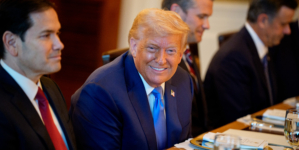-
Man Dies at Milan Airport After Being Sucked Into Jet Engine, Official Says - 14 mins ago
-
Red Sox $11 Million Closer Among ‘Most Logical’ Players to be Traded - 31 mins ago
-
Extreme heat is a big problem for parents of young kids — and schools - 48 mins ago
-
‘Diddy Parties’ Became a Meme. The Combs Case Was About Something Else. - 58 mins ago
-
Donald Trump Drops Below Joe Biden, Hillary Clinton in Popularity Ranking - about 1 hour ago
-
Susanna MacManus, doyenne of Olvera Street’s Cielito Lindo, dies - about 1 hour ago
-
Elon Musk’s Net Worth Takes $15B Hit After Forming New Political Party - 2 hours ago
-
Norman Tebbit, Former U.K. Minister and Close Thatcher Ally, Dies at 94 - 2 hours ago
-
Heat wave bringing toasty temperatures to Southern California - 2 hours ago
-
Adam Hadwin’s Wife, Jessica, Has 48 Reasons Why PGA Tour Life is the Best - 2 hours ago
Trump’s $36 Billion Army Reform: What ‘Generational Change’ Looks Like
The Trump administration is initiating a $36 billion overhaul of the U.S. Army, modernizing systems and updating weapons—such as next-generation tanks and helicopters—that will bring about a “generational change,” an Army spokesperson told Newsweek.
Why It Matters
The Pentagon has repeatedly raised concerns about the state of the U.S. military in relation to China over the past two administrations, with officials and leadership labeling China a pacing challenge for the U.S. military. This means they view China as a long-term risk to U.S. influence and power.
The last major equipment overhaul of the U.S. Army occurred during the late 1970s and mid-1980s with the introduction of the “Big Five” weapons systems: the M1 Abrams tank, M2/M3 Bradley Fighting Vehicle, AH-64 Apache attack helicopter, UH-60 Black Hawk utility helicopter and the Patriot air defense missile system.
What to Know
The overhaul is part of President Donald Trump’s efforts to counter China’s aggressive military. U.S. Secretary of Defense Pete Hegseth signed a memo on Wednesday that directed the Pentagon to “build a leaner, more lethal force” by “divesting outdated, redundant, and ineffective programs, as well as restructuring headquarters and acquisition systems.”
“Simultaneously, the Army must prioritize investments in accordance with the Administration’s strategy, ensuring existing resources are prioritized to improve long-range precision fires, air and missile defense including through the Golden Dome for America, cyber, electronic warfare, and counter-space capabilities,” Hegseth wrote in his memo.
The upgrade will cost $36 billion spent over five years to complete, starting in financial year 2026, which commences July 1, 2025.
Colonel David Butler, an Army spokesman, spoke with Newsweek about some of the specifics that the administration is looking to enact, with the understanding that “the proof will be in the execution of it,” but the belief that “this is going to be a generational change for the army.”

Bo Amstrup/Ritzau Scanpix/AFP via Getty Images
“For decades, without overstating it, the Defense Acquisition System is archaic,” Butler said. “I think what’s happening now is people just realize that it’s right in front of our faces: You could see the battlefield in Ukraine is moving technologically. It’s moving so fast, it’s rapidly changing, you know, three weeks at a time, if not faster.”
“We’re seeing the same thing in Israel, the way the Israeli military had to adapt and change,” Butler continued. “Our defense acquisition system could never keep up with that, and so I think—I can’t speak for why we haven’t been able to do it up until now.”
The defense acquisition system is meant to “support the National Defense Strategy through the development of a more lethal force based on U.S. technological innovation and a culture of performance that yields a decisive and sustained U.S. military advantage,” according to the Pentagon.
The Army will look to equip each active-duty division with around 1000 drones, but Butler said that the Army would also look to invest in counter-drone technology, which he said “we’re way behind in,” in addition to investing in electronic warfare—spectrum detection and jamming capabilities—as well as artificial intelligence (AI) and robotics.

Omar Marques/Getty Images
“We’ve got to continue to invest in our network infrastructure, connected via Starlink and Star Shield and other satellite communications,” Butler said. “That’s come a long way. The Army’s got to invest quite a bit into that, because over the past 20 years we’ve gotten wayward in how our network is built and conducted.”
“We are going to operate across several different lines of effort, but one of the one of the baseline things that we have to get right, we’ve already started this and we’re going to continue, is the network infrastructure,” he added.
The improvements Butler mentioned aimed to “lower our signature on the battlefield,” as “a single electronic emissions give away our location and allow us to be targeted.”
“This is all in an effort to have a much, much smaller footprint, reduce our electronic emissions, and be less targetable, so that we can be the ones targeting instead the ones targeted,” he said.
With AI, the Army will be able to more quickly and accurate process information on production and program progress that currently is tracked through “tens of thousands of civilians that are filling out Excel spreadsheets and passing those around via email.”
“We’re doing a series of pilots with AI companies that apply AI to that system … and initial findings is AI is obviously much, much faster, it’s much more accurate, and it’s also pulling out data that enables us to see the programs in a different way,” he said, such as highlighting anomalies and trends – just one of several ways the Army will integrate new technology.
What People Are Saying
U.S. Secretary of Defense Pete Hegseth wrote in his memo: “The President gave us a clear mission: achieve Peace through Strength. To achieve this, the United States Army must prioritize defending our homeland and deterring China in the IndoPacific region. Deterring war, and if required, winning on the rapidly evolving battlefield requires Soldiers who are physically and mentally resilient, rigorously trained, and equipped with the best technology available.”
Oxford University International Relations Professor Neta C. Crawford, who has written extensively on U.S. and global military expenditure trends, told Newsweek: “This spending saps the rest of the U.S. economy. But it is also unnecessary. Any military budget needs to be shaped by a military strategy that is sized to the threat. China is not now a match for the U.S., and Russia is a greatly weakened military power after years of fighting in Ukraine.”
What Happens Next
The Army will continue its review of spending and systems to pinpoint areas of improvement and work to overhaul those weaknesses over the course of Trump’s second term in office.
Source link

















